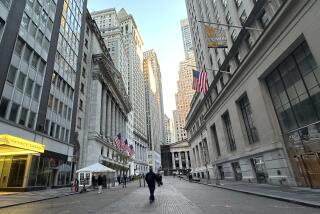FINANCIAL MARKETS : Falling Yields Push Dow Up 7.26 Points
Market Overview
The continued decline in long-term interest rates again helped stocks higher Tuesday in lethargic trading. Major market indicators set record highs for the second time this week.
Long-term bond rates declined again after an unusually volatile session buffeted by waves of buying and selling. Shorter-term maturities were slightly lower to unchanged.
The dollar rose against most major currencies, buoyed by better than expected data on the U.S. economy for the second quarter. Gold also rose.
Stocks
Despite the positive finish, stocks were directionless ahead of the Labor Day weekend, with many investors already on vacation.
Shares traded in a narrow range, closely mirroring bond prices.
The Dow Jones industrial average rose 7.26 points to 3,651.25, rallying in the final minutes of trading after languishing in negative territory for much of the day.
In the broader market, advancing issues outnumbered declines by about 3 to 2 on the New York Stock Exchange. Big Board volume came to 252.83 million shares, up from Monday’s 194.18 million.
The NASDAQ index rose 4.88 to 742.26, surpassing its previous record of 737.38, set Monday. Microsoft led the advance, rising 2 1/2 to 75 1/8 after the company said a government contract for personal computers awarded to Zenith Data Systems and GTSI will include Microsoft programs.
NASDAQ stocks are strong because, given the present environment, “it won’t be easy to make money in the stocks of companies that are sensitive to swings in the economy--the large, highly capitalized companies trading on the NYSE,” said Hugh Johnson, chief investment strategist at First Albany Corp.
Instead, investors are looking to the “smaller niche companies where management is actively involved in running the company,” he said.
Among the market highlights:
* Technology stocks were strong. Lotus Development moved up 1 3/4 to 35 1/4 and Intel rose 1/4 to 64 1/4.
* Limited topped Big Board stock activity, off 1/4 to 23 3/8 on news of a major restructuring, including the closing or downsizing of some Limited and Lerner stores. It will also buy back up to $500 million of its common stock.
* Cisco Systems lost 2 to 47 3/4. Hancock Institutional downgraded its rating to “hold” from “buy” on the firm.
* Nextel Communications surged 3 3/8 to 38 3/4 after it activated the nation’s first digital mobile network in Southern California.
* SmithKline Beecham fell 1 1/2 to 32 3/4 after a Wertheim Schroder & Co. analyst downgraded the stock, citing possible weak sales in the company’s drug business next year.
* Fibreboard helped lead the index higher for a second day, rising 2 3/4 to 22 7/8. Two insurers have agreed to pay an estimated $3 billion for asbestos claims against Fibreboard.
Markets were mixed in overseas trading. In Frankfurt, the 30-share DAX average closed 23 points higher at 1,944.89. Stocks also ended higher in Tokyo, with the Nikkei average closing above 21,000 for the first time since June 3. The Nikkei ended up 113.91 points at 21,026.60. London’s Financial Times 100-share average ended 0.6 points down at 3,100.0.
Credit
Analysts and traders said the main factors driving the bond market were the government’s report on economic growth and heavy bond buying by the Federal Reserve Board as part of its seasonal operations to replenish banking system reserves.
By day’s end, the yield on the key 30-year bond had fallen to 6.10% from 6.11% on Monday.
Its price, which moves in the opposite direction, was up 3/16 point, or 31 cents per $1,000 in face value.
The market initially rose, then fell as traders reacted to the Commerce Department’s revised report on the gross domestic product. The department said the U.S. economy grew at a modest 1.8% annual rate in the April-June quarter. That followed a barely perceptible 0.8% gain in the first quarter.
While the increases showed lackluster growth, they were slightly better than what the department originally reported a month ago--1.6% in the second quarter and 0.7% in the first.
But the market resumed its rise after the Fed announced that it had bought notes and bonds as part of its seasonal operations.
By the close, the market had managed to mostly recover.
The federal funds rate, the interest on overnight loans between banks, rose to 3.2% from 3.1% on Monday.
Other Markets
Traders said the dollar jumped after the Commerce Department released it revised GDP report.
“It wasn’t a tremendous boost, but in the last week or so it feels like the dollar has been stuck in a range,” said Matt Porio, a vice president at Chase Manhattan. “This gave it an impetus.”
But Lisa Finstrom, a currency analyst at Smith Barney Shearson, said the dollar gained only a limited amount from the new GDP number because it was based in part on higher than expected government spending.
“That’s not the same thing as definitive growth,” she said.
The dollar closed in New York at 104.74 Japanese yen and 1.677 German marks, up from Monday’s 103.83 yen and 1.672 marks.
Gold prices were up in New York and mixed overseas. On the New York Commodity Exchange, gold for current delivery closed at $373.00 an ounce, up $2.40 from Monday. Silver for current delivery closed at $4.838 an ounce, up 0.6 cent.
Profit taking sank energy futures prices on the New York Mercantile Exchange, with light, sweet crude oil for October delivery falling 44 cents to $18.29 a barrel.
Market Roundup, D6
More to Read
Inside the business of entertainment
The Wide Shot brings you news, analysis and insights on everything from streaming wars to production — and what it all means for the future.
You may occasionally receive promotional content from the Los Angeles Times.










